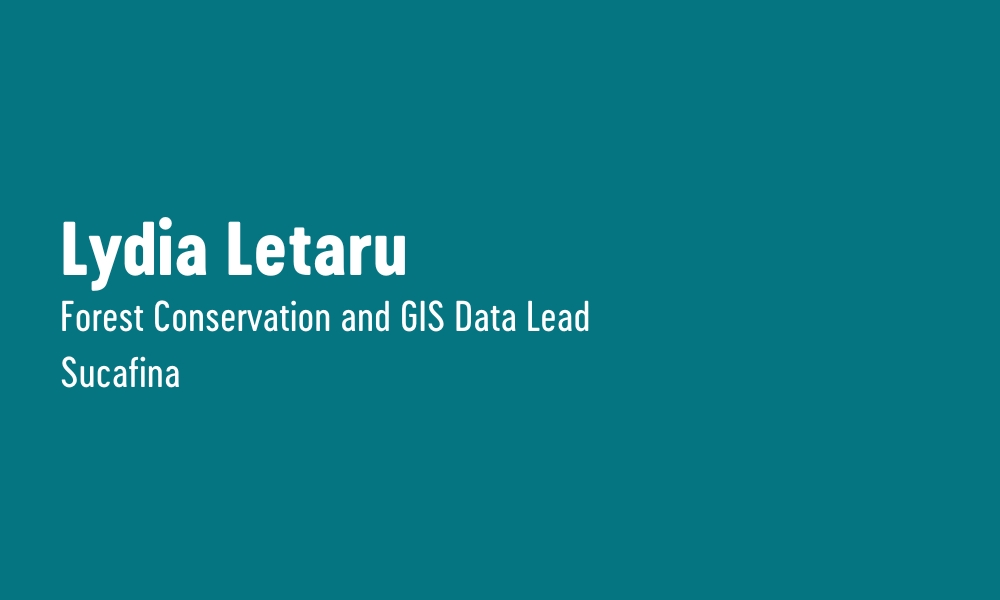

September 25, 2025 – Monitoring deforestation risk is a key focus of the Forest Conservation Goal area of Sucafina’s IMPACT Program. As we continue to prepare for the European Union Deforestation Regulation (EUDR), accurate data collection is key to compliance and traceability. Lydia Letaru, Forest Conservation and GIS Data Lead, shares her insights into our process, the challenges we face and how we’re addressing them.
1. What does your role as Forest Conservation and GIS Data Lead involve?
I oversee our efforts in managing plot-level geolocation data for deforestation assessments and aligning that data with EUDR requirements.
We collect data from both our direct and indirect supply chains. To ensure consistency and reliability, we need to standardize the data (sometimes it comes in different formats or may be missing elements). Then I run a series of checks, using an in-house tool I co-developed, to ensure the data is valid for EUDR compliance. For example, farms over 4 hectares must be mapped using a polygon (marking exact boundaries, not just a single GPS point). We also check that polygons don’t have errors, such as holes or self-intersections, and that plots don’t overlap with protected areas.
After running these checks, I liaise with the data providers to address any issues identified. This might include requests to remap plots or for evidence of permission to grow coffee in protected areas. Once validated, I submit the data for deforestation assessment using the Trade in Space (TiS) platform. I also support our Origin teams with training on these tools, perform geolocation checks on the EU Traces platform and assist clients with submitting data to the system.
2. Can you summarize our process for collecting and managing data to monitor for deforestation risk?
The first step is collecting geolocation data for each farm by recording the GPS points and/or polygons. After performing geometric checks, we use the TiS platform to assess potential deforestation risk. TiS tracks tree cover changes over the past two decades using satellite imagery, highlighting tree-loss incidence within the European Commission Joint Research Council’s global forest map. It also provides alerts of possible deforestation near protected forest areas.
These open-source global forest datasets can have limitations, so we also carry out secondary verification either using high-resolution satellite images or by ground-truthing to uncover the reason for tree-cover losses. For instance, trees might have been lost due to natural hazards, like wildfires, or might reflect that a farmer has renovated their coffee trees, meaning that the farm is still compliant.
3. Why is collecting rigorous farm-level data so important for EUDR compliance and traceability?
Accurate data is the foundation of effective deforestation monitoring. Our goal is to ensure that every farm is mapped correctly so we can provide reliable insights and support farmers in maintaining sustainable land use. Deforestation assessments are performed based on the farm-plot’s mapped geometry.
If the mapped area isn’t accurate – for example, if it doesn’t reflect the farm’s true boundaries – a deforestation-free plot could end up being flagged as non-compliant. These issues can also negatively impact estimates of the expected yield from a particular farmer or supply chain.
4. What are some of the biggest challenges in collecting this data and how is Sucafina addressing them?
In countries where we rely on suppliers, intermediaries or cooperatives for data, we work closely with key partners to strengthen transparency and improve the quality of the data they share.
In countries with many smallholder farmers, such as in East Africa, generating accurate farm-level geometry can be time-consuming and expensive. Through IMPACT, Sucafina’s responsible sourcing program, our Sustainability and Certification Officers are working to increase the number of mapped plots in our direct supply chains. We also encourage our suppliers to map and provide farm geometry.
Another challenge is that the forest cover and forest loss baseline datasets are not always accurate. This leads to higher levels of false positives, which need to be followed up via desk review or field visits. We are working with TiS to refine the methodology to reduce the number of false positives, improving efficiency and accuracy across the board.
Read our 2024 Sustainability Report to learn more about how we’re advancing Forest Conservation, as well as driving progress across our other four IMPACT Goals.